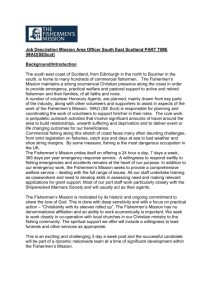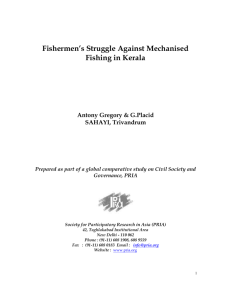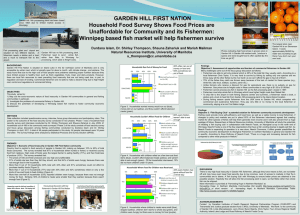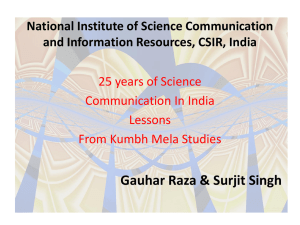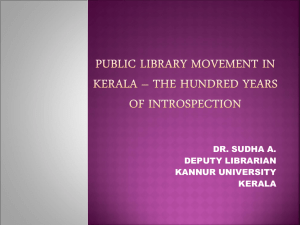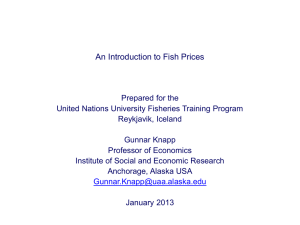Document
advertisement
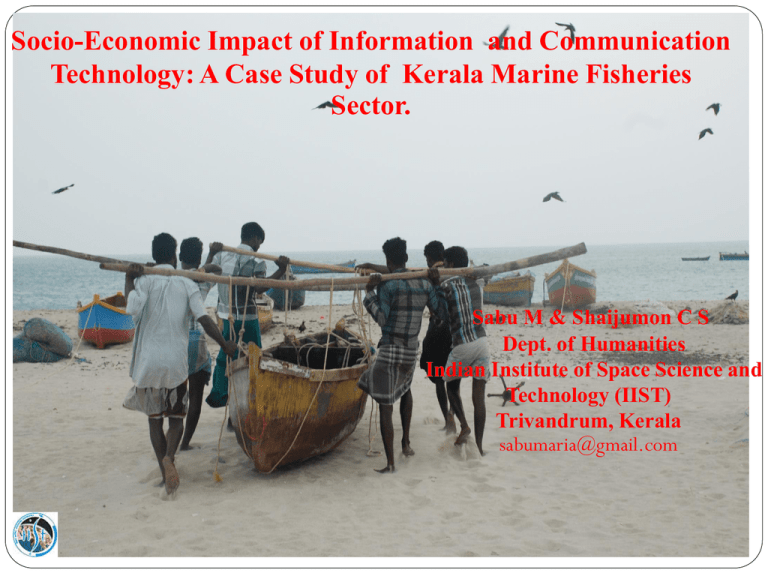
Socio-Economic Impact of Information and Communication Technology: A Case Study of Kerala Marine Fisheries s Sector. Sabu M & Shaijumon C S Dept. of Humanities Indian Institute of Space Science and Technology (IIST) Trivandrum, Kerala sabumaria@gmail.com Profile of Kerala Marine Fisheries Coastal length: 590 km No. of landing centres: 187 No. of fishing villages: 222 Fishermen population: 6,10,165 Fishermen families: 1,18,937 Mechanized crafts: 4,722 Motorized crafts: 11,175 Non-motorized crafts: 5,884 Major fishing gears: Trawlnet, Ringseine, Gillnets, Hooks & lines Total landings in 2012: 8,39,185 Important species/groups: Oil sardine, Mackerel, Penaeid prawns, Threadfin breams, Scads Introduction Technological invention , innovation and diffusion are important sources of economic development. Innovation has its impact only when a technology is successfully diffused Normally, diffusion process shows S shaped curve (Rogers, 1995) S shaped cv shows– innovators, early adopters, early majority, late majority and laggards Diffusion of ICTs – a general purposive technology - its positive impact in fisheries sector is very significant in present scenario of Kerala economy. What causes in the fisheries sector of Kerala by the continuous adoption of ICT tools- GPS, Echo-sounder, Wireless set, Mobile phone and Beacon? How is the usage level of ICTs in marine fisheries sector of Kerala? Kerala –highest contributor (2012). 8.41 lakh tonnes (2012) - 8 percent of the GSDP from the agriculture sector Kerala fisher folk population - 10.02 lakh covering 7.71 lakh in coastal- 2 lakh active fishermen (CMFRI, census 2010) Contd… Avg fish landings and fishing fleets- no substantial increase in the fish catch Only 31.46 % of offshore waters are exploited scope for exploitation of 1. 25 million tonnes of deep sea resources (CMFRI 2012). Importance of deep sea fishing and relevance of Information and communication technology tools. A technological diffusion in Kerala has occurred from many centuries before. Modernization of technology- 1950s Norwegian – INP- new methods of fishing and new types of gear Mechanization of crafts –1953 Motorization of crafts (SIFFS) – 1980 GPS application – 1990s Mobile application - 1997 ICTs- Global Position System (GPS), Eco-sounder, Mobile phone, Wireless set, Radar and Beacon in fishing can contribute more in the economy by enhancing more productivity of fish. The level of usage of tools and its economic impact on fishermen is more relevant to study in this context. Marine and inland fish production all India (2010-2011) Marine 45% Marine and inland fish production Kerala (2010-2011) Inland 55% Inland 18% Source:CMFRI annual report, 2011 Marine 82% Marine fish landings in Kerala 9 8 Lakh in tonne 7 6 5 4 3 2 1 0 2000 2001 2002 2003 2004 2005 2006 2007 2008 2009 2010 2011 2012 Year Source: CMFRI, various annual reports Objective of the study To assess the socio-economic impact of information and communication technologies among fishermen in Kerala. To evaluate the usage of ICT tools and problems faced by the fishermen of Kerala. Methodology Both quantitative and qualitative The primary data were collected from the two fishing community of Munambam in Ernakulam district and Pozhiyoor in Thiruvanathapuram district for the comparative study purpose . Unit of samples were motorised sector fishermen in Pozhiyoor and Mechanized sector fishermen in Ernakulam, Kerala and total sample size was 50. Secondary data were collected from various surveys, various reports, marine census and research studies. Focus group discussion was done in each fishing areas for deep understanding of real situation. Munambam Study Areas Pozhiyoor Review of Literature- World No. Authors Remarks 1 Samsons (2006) They presented the result of pilot fishnet initiative (FNI) – Nigeria- Information on marketing and fish distribution through - high effectiveness of ICT- TVs, leaflets, radio, posters etc- 2 FAO (2007) New (ICTs) —empowerment-Manobi weather reports and market prices using via mobile phones-launched a GIS system, using GPS to increase protection at sea for fishermen and their 3 Hassan et.al. (2011) Malaysia- significant relation- productivity increasessimple arithametic calculations. 4 Shaffril (2011) Malaysia. - a pre test study -reliability and validity & measuring usage of GPS, sonar, echo sounder, wireless set ad mobile phone among the fishermen 5 Mahamadu (2011 Ghana -mobile phone - cost reducing factors, safety factors, coordination factors, and market expansion factors. Review of Literature - India No. Authors Remarks 1 Gine (2005) Credit constraints - faced by relatively poor boat owners are important - long run the innovation benefited the poor more than proportionally - Kuznets inverted u shaped inequality curve. 2 De (2008) Aquaculture farmers – role of ATIC)-technological information along with technology inputs and products for testing and use –NICT-to improve the communication, disseminate information and share knowledge and skill. 3 Govindaraju (2010) Tamil Nadu- VKC (Village Knowledge Center)- egovernance, e-agriculture, e-education,e-health and other services at free of cost-information about mobile phone with GPS 4 Mary (2011) Kanyakumari-ICT usage – mobile (70%) – radio (28%)know more about modern technology and make use of it for efficiency is the most challenging factor. Review of Literature - Kerala No. Authors Remarks 1 Achari & Menon (1963) Mechanical technology in fishing led to a commendable increase in the number of mechanized boats that led to increase in assets as well as liabilities of boat owner households. 2 John Kurien (1999) Diffusion of plywood boat(1980-91)- innovators, early adoptors & early followers- 3 Abraham (2006) Mobile phones has led a significant role in Kerala marine industry – prod uctivity enhanced 4 Jensen (2007) Mobile phones among Kerala fishermen CV of price declined from 60–70 to 15 percent or less - no violations of the Law of One Price – No wastage 5 Pillai & Prethia (2010) PFZ advisories generated by (INCOIS) along the Kerala coast during 2006-2010, was very much useful for artisanal, motorized and small mechanized sector higher catch per unit effort for the major pelagic and improving fishing operations. Study Analysis Social Impact Age wise Education Asset ownership Period of using ICT tools Economic Impact Average income Income expenditure of fishermen Benefits from using ICT tools Debt Usage of ICT tools Social Impact Age wise analysis Age Munambam Pozhiyoor (%) (%) Less than 25 30 - 25-35 45 35 35-45 25 50 45-55 - 10 55-65 - 5 Education of the fishermen Education Munambam (%) Pozhiyoor (%) No Formal Education 25.0 55.0 Primary School 35.0 40.0 Upper Primary 5.0 - High School 35.0 5.0 Total 100.0 100.0 Own trawler/vessels of fishermen 100 90 80 70 60 Yes No 50 40 30 20 10 0 Munampam Pozhiyoor Period of using ICT tools in Munambam and Pozhiyoor Year Munambam Pozhiyoor (Percent) (Percent) 1 year but less than 2 -- 5.0 2 years but less than 3 -- 10.0 3 years but less than 5 55.0 65.0 Greater than 5years 45.0 20.0 Total 100.0 100.0 Economic Impact Average monthly income of Munambam and Pozhiyoor fishermen(in percent) 70 60 50 40 30 20 10 0 5000-10000 10000-15000 15000-20000 Munambam 20000-25000 Pozhiyoor Benefit of ICT tools for the fishermen Impact Munambam Pozhiyoor (Percent) (Percent) 10.0 10.0 0 5.0 70.0 40.0 Iincreased income level, increased productivity level and inncreased communication 5.0 10.0 Increased income and productivity 15.0 35.0 Increased productivity of fish Increased communication Increased productivity, increased income level and improved standard of living Income spend by fishermen Income spend Munambam (%) Pozhiyoor (%) House Construction 5.0 10.0 Debt Repayment 10.0 15.0 Food House Construction Educating Children Debt Repayment 65.0 Food Debt Education Others 25.0 20.0 0 30.0 5.0 Usage of ICTs tools 120 100 Percent 80 GMWE GMW 60 40 20 0 Munambam pozhiyoor Cross tabulation Average monthly income What is level of education (Munambam & Pozhiyoor) No formal educaiton Primary school Upper primary High school 5000-10000 33.3% 33.3% 5.6% 27.8% 10000-15000 16.7% 33.3% .0% 50.0% 15000-20000 14.3% 71.4% .0% 14.3% 20000-25000 77.8% 22.2% .0% .0% Availability of fishing kit in Munambam and Pozhiyoor Items Munambam Pozhiyoor (Percent) (Percent) Safety kit 0 87.5 Wireless 0 12.5 Total 0 100.0 Major findings All the fishermen of case study area are the migratory fishermen The majority of the fishermen in Pozhiyoor coastal village are labours with age group of 35-45 (50%) and only a few is the owner of a gill-net boat (30%) and it is zero in Munambam. The majority of the fishermen in Munambam is engaged with trawling boat , would go up to 150nml and Gill Boats (100-200 nml) by Pozhiyoor fishermen. All they got information about such new technology from their own friends and colleagues. All the fishermen in the both the coastal villages revealed that GPS wireless and echo sounder increased their productivity , income and standard of living There is no updated information is about weather forecasting at sea they usually approach traditional method still now. The mobile phone helped a lot both the fishermen to know the available market price and communicate with their dear ones when they reach around This study also reveals that there is no any relation between education of fishermen and capability of fishermen using such technologies. The problem regarding ICT tool is its poor accessibility and lack of using beacon for life safety. No any VIC,VKC,VRC in the research area and no role of PFZ.
